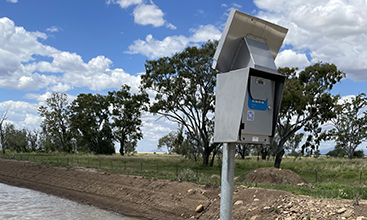How suppliers and manufacturers can meet an increasing demand for metering equipment
The department estimates that under the non-urban metering rules, according to licensing records, up to 23,000 sites will need compliant meters and local intelligence devices (LIDs) in NSW.
The department has developed an industry guide for meter manufacturers, installers and validators to help the market prepare to meet increased demand. It indicates the number of works estimated to need a new or replacement meter under the framework.
Read the Industry guide for works requiring a meter (PDF, 499.43 KB)
What metering equipment is required under the non-urban metering rules?
Works captured by the non-urban metering rules must be fitted with the following three components, and certified by a duly qualified person, such as a certified meter installer.
| Components | Description |
|---|---|
| A compliant meter that accurately measures water take. |
Meters installed on or after 1 April 2019 must be pattern-approved
Meters installed before 1 April 2019 don’t have to be pattern-approved but must be shown to be +/- 2.5% accurate in factory conditions or +/- 5% accurate in the field. The Commonwealth National Measurement Institute is responsible for providing pattern-approval of meters. The MDBA maintains a list of pattern-approved non-urban water meters on its website. |
| A local intelligence device (LID) that records the water taken through your work and makes the data recorded available to government. |
LIDs for surface water pumps, except pumps less than 200 mm in diameter, must transmit water take information to the NSW Government’s telemetry system.
LIDs for other works must either transmit water take information to the NSW Government’s telemetry system or this data must be available onsite for WaterNSW and NRAR field staff who are authorised officers. All LIDs must meet the technical specifications approved by the Minister. The department maintains a list of local intelligence devices that meet these specifications. |
| Tamper-evident seals that show if equipment has been interfered with. |
Irrigation Australia Limited is responsible for supplying compliant tamper-evident seals.
Tamper-evident seals can only be installed or broken by a duly qualified person, such as a certified meter installer, or a Water NSW or NRAR employee who is an authorised officer. |
What is a pattern-approved meter and how does a supplier get a meter pattern-approved?
A pattern-approved meter is a meter that has been approved by the National Measurement Institute under the National Measurement Regulations 1999 (Commonwealth) as meeting the Australian Standard for non-urban water meters (AS4747).
The Murray–Darling Basin Authority (MDBA) maintains a list of pattern-approved non-urban water meters.
A meter must undergo a range of physical tests at a National Association of Testing Authorities accredited laboratory, such as Manly Hydraulics Laboratory in NSW or the Australian Flow Management Group in South Australia to check if it is compliant with the AS4747.
If the meter passes testing, it can be pattern-approved as compliant with the requirements:
- for closed conduit meters (NMI-M10)
- for open channel meters (NMI-M11)
- of equivalent overseas standards.
For more information about the process for having a meter pattern-approved, please contact National Measurement Institute at infotm@measurement.gov.au or Manly Hydraulics Laboratory.
What is a local intelligence device and how does a supplier get a local intelligence device listed?
A local intelligence device (LID) connects a meter to securely record information about water take and make that information available to government, either by transmitting it to the NSW Government’s telemetry system or allowing an on-site download.
A LID must meet the minimum technical specifications set out in the NSW Data Logging and Telemetry Specifications 2021 (PDF, 1900.85 KB). These specifications define the minimum requirements for ensuring a satisfactory level of functionality, data integrity and security for LIDs.
The department maintains a list of LIDs that have been shown to meet these requirements.
How the department will work with LID suppliers
The department’s Market Engagement Policy for Telemetry (PDF, 593.52 KB) describes:
- how we will engage with providers of telemetry solutions that support the non-urban metering and floodplain harvesting measurement rules
- the process and criteria for assessing whether telemetry solutions and on-farm or third party telemetry systems, can operate within the government‘s telemetry system.
The policy also describes the process for confirming that a LID meets these requirements (PDF, 1900.85 KB). If the device does meet these requirements, the department publishes details about it on its website.
For more information about the process for having a LID listed, please email the department at metering.reform@dpie.nsw.gov.au.
Compatible local intelligence devices
A local intelligence device (LID) connects a pattern-approved meter to securely record information about water take and make that information available to government, either by transmitting it to the NSW Government’s telemetry system or allowing an on-site download.
The department maintains a list of LIDs that have been shown to meet the functional and security requirements of the NSW Government’s data acquisition system (DAS), as described in the Data Logging and Telemetry Specifications 2021. This list does not provide any form of warranty, reliability or suitability of listed devices, including for specific environmental conditions, metering equipment configurations or signal interfaces.
The testing of devices and solutions for the purposes of listing is limited to their ability to connect to the DAS, meet specific security and data integrity requirements described in the Data Logging and Telemetry Specifications 2021.
Read the Data Logging and Telemetry Specifications 2021 (PDF, 1900.85 KB)
Important information
The product trade names in this publication are supplied on the understanding that no preference between equivalent products is intended and that the inclusion of a product name does not imply endorsement by the department over any equivalent product from another manufacturer.
Compatible LIDs for Non-Urban Metering
A list that sets out LIDs that meet the non-urban metering requirements.

